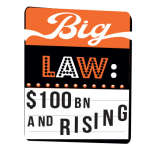Judging the world’s largest law firms, it is becoming a familiar tradition after we unpack the results of the Global 100 to look ahead to a more troubled outlook… which then turns into another year of robust growth.
Take 2019’s results, one of the strongest showings since the banking crisis a decade ago, which have seen the group push revenue up 9% to $113.51bn, while profits per equity partner (PEP) across the 100 increased 7% to an average $1.87m. Over a third of firms saw revenues increase by more than 10%, up from 16 in 2016; just four saw declining turnover. While underlining revenue per lawyer once again barely moved upwards, there are now 19 firms with PEP in excess of $3m, all bar one American, and eight exceeding $4m.
The primary reason for this performance is as plain as a bald eagle sitting atop Nelson’s Column: gravity-defying performance from the US economy, which has now reached a record-breaking 121 months of consecutive growth. Almost as striking was research this year from Mergermarket, which saw US activity for the first time constitute more than half of global M&A activity in the first six months of 2019.
Such results denote less domination by the Wall Street legal elite. Plenty of prominent brands like Cleary Gottlieb, Skadden, Sullivan & Cromwell and Weil Gotshal posted indifferent years even as Paul Weiss, Milbank, Davis Polk and Simpson Thacher roared ahead. The broader performance was driven instead by the two long booms in alternative capital and the technology industries (as we report this month in our piece on California), the sheer heft of the US economy and the incredible profitability of the top 1% of US M&A, regulatory and disputes work. So repeating another familiar pattern, standout performances are as likely to have hailed from the West Coast, Chicago or Boston as Manhattan.
Against that backdrop were robust performances at Kirkland & Ellis (with a 19% hike in revenue to close in on the $4bn revenue mark), Latham & Watkins, Goodwin Procter, Cooley, Covington & Burling, Ropes & Gray and King & Spalding. The notable exception to this pattern is LA-bred disputes leader, Quinn Emanuel, which posted its second year of sedate growth, suggesting its business is now mature and the surging year-on-year growth is behind it.
It was not in general a great year for generalists, with many of the standout performers being precisely adapted to busy chosen markets. Baker McKenzie and White & Case were partial exceptions to that rule, though both have become more focused on high-end work in core money hubs in recent years.
Such utter US domination obviously raises awkward questions for the Magic Circle, which we address in this month’s cover feature on Freshfields Bruckhaus Deringer. After yet another year in which they failed to keep pace with US Global Elite rivals, the group surely need a thoughtful strategic take on the world’s largest legal market. The pretence that their US operations are on track to come good in time becomes more threadbare by the year – the market is pulling away from them and more of the same will not change that. It is time to at least consider the possibility of abandoning substantive US coverage and if they can’t face that, then to consider what precisely their partnerships can stomach because the UK leaders are currently stuck with the worst of both worlds.
But it is hard to judge the City elite too harshly in striving to compete under these conditions. Do any foreign law firms have credible responses to the enduring phenomenon of the US legal market? The question has become an annual tradition of its own.













